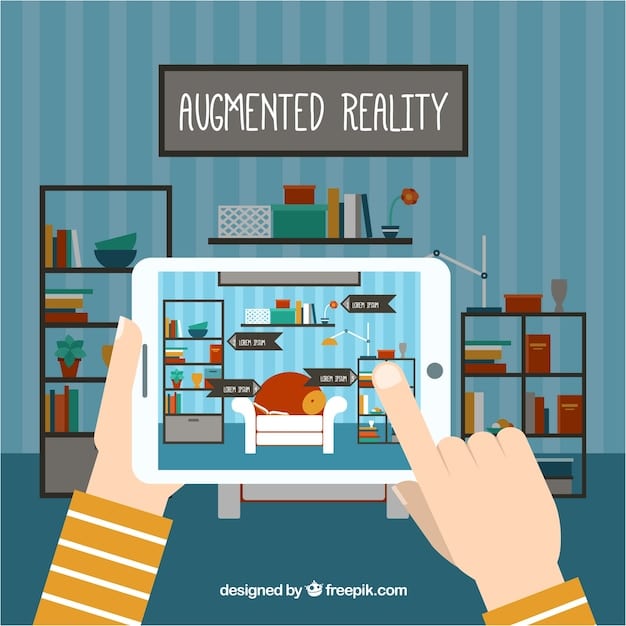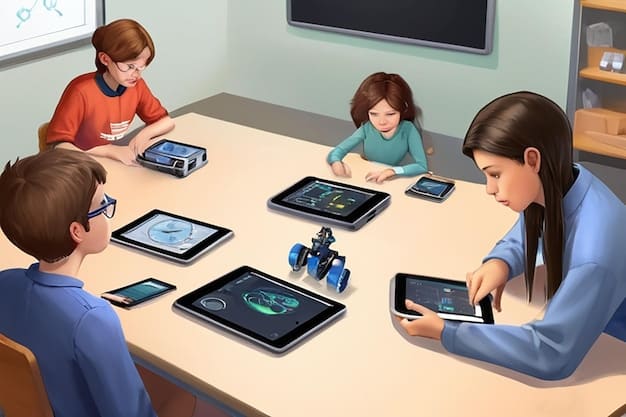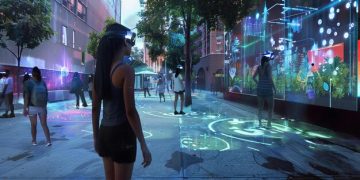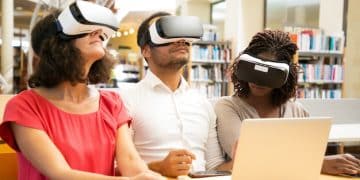Augmented Reality (AR) in the US: Transforming User Experiences

Augmented Reality (AR) applications in the US are transforming user experiences across various sectors by seamlessly blending digital content with the real world, offering innovative solutions for retail, education, healthcare, and entertainment.
The landscape of technology is constantly evolving, and one of the most exciting developments is the rise of augmented reality (AR) applications: enhancing user experiences in the US. AR is no longer a futuristic concept; it’s a present-day reality that is transforming how we interact with the world around us.
Understanding Augmented Reality Applications in the US
Augmented reality is changing the way Americans interact with technology. It enhances real-world environments with computer-generated perceptual information, offering a unique and interactive experience. From mobile apps to wearable devices, AR is finding its place in various industries across the United States.
What is Augmented Reality?
Augmented reality (AR) is a technology that overlays digital content onto the real world. Unlike virtual reality (VR), which creates a completely virtual environment, AR enhances what you already see. This is typically achieved through smartphones, tablets, or AR glasses.
Key Components of AR Technology
Several components make AR technology work seamlessly. These include sensors, cameras, displays, and processors. Sensors and cameras capture the real-world environment, processors handle the data, and displays project the digital content.
- Sensors and Cameras: Capture and interpret real-world data.
- Processors: Handle the complex calculations for content overlay.
- Displays: Project digital content onto the real world.
Ultimately, augmented reality blends the digital and physical worlds, offering immersive experiences across different industries. Its functionality relies on complex technology that continues to advance, paving the way for broader applications.
AR in Retail: A New Shopping Experience
The retail industry is one of the early adopters of augmented reality. AR applications enhance the shopping experience, allowing consumers to visualize products in their homes before making a purchase. This technology not only provides convenience but also increases customer engagement and satisfaction.

Virtual Try-On and Placement
AR applications enable virtual try-on experiences for clothing, accessories, and cosmetics. Customers can see how a product looks on them without physically trying it on, improving the online shopping experience and reducing returns.
Enhanced Product Information
By pointing their smartphones at products in a store, customers can access detailed information, reviews, and promotional offers. This enhances the in-store shopping experience, providing valuable information at their fingertips.
AR applications in retail redefine the customer journey, combining the convenience of online shopping with the tangibility of physical stores. By providing personalized and visually appealing experiences, AR helps retailers increase sales and build stronger customer relationships.
Healthcare Applications: Improving Patient Care
Augmented reality is making significant strides in the healthcare industry. From assisting surgeons during procedures to enhancing patient education, AR applications improve the quality of care and efficiency. These advancements are transforming how medical professionals train, diagnose, and treat patients.
Surgical Assistance and Training
AR provides surgeons with real-time guidance during procedures by overlaying digital images onto the patient’s body. This helps improve precision and reduces the risk of complications. AR is also used for training medical students, offering a safe and interactive learning environment.
Patient Education and Rehabilitation
AR applications help patients understand their conditions and treatment plans. By visualizing medical information in an engaging way, patients become more informed and involved in their care. AR is also used in rehabilitation, providing interactive exercises and monitoring progress.
- Surgical Precision: Real-time guidance during surgeries.
- Medical Training: Interactive learning environments for students.
- Patient Engagement: Enhanced understanding of conditions and treatments.
Applications of AR in healthcare are revolutionizing how care is delivered and received. By providing innovative solutions for training, diagnosis, and treatment, AR is paving the way for a more efficient and patient-centered healthcare system.
Education and Training: Interactive Learning Experiences
Augmented reality is transforming education by creating interactive and engaging learning experiences. AR applications bring textbooks to life, allowing students to visualize complex concepts and explore topics in a more hands-on way. This enhances understanding and retention, making learning more enjoyable.

Interactive Textbooks
AR-enhanced textbooks allow students to scan images and access 3D models, animations, and additional information. This turns static content into dynamic learning experiences, capturing students’ attention and fostering a deeper understanding of the material.
Virtual Field Trips
AR enables virtual field trips to historical sites, museums, and natural environments. Students can explore these locations from the classroom, making learning more accessible and engaging. This provides enriching experiences that would otherwise be impossible.
Applications of AR in education create new possibilities for teaching and learning. By providing immersive and interactive experiences, AR enhances student engagement and knowledge retention, preparing them for future success.
Entertainment and Gaming: Immersive Experiences
The entertainment and gaming industries have embraced augmented reality to create immersive and engaging experiences. AR games overlay digital characters and objects onto the real world, turning everyday environments into interactive playgrounds. This provides a new level of realism and engagement, enhancing the overall gaming experience.
AR Games and Applications
AR games like Pokémon GO have demonstrated the potential of AR to blend digital and physical worlds. These games encourage players to explore their surroundings and interact with virtual characters, creating a unique and exciting gaming experience.
Interactive Entertainment
AR applications are used to enhance live events, concerts, and theme park attractions. These applications overlay digital content onto the real world, providing attendees with interactive experiences and additional entertainment value.
- Engagement: Enhances user interactivity
- Immersion: AR provides deeper and more personal immersive experiences
- Realism: Creates a new level of realism blending digital and physical locations
AR’s capabilities in entertainment and gaming are transforming how people experience media and leisure. By offering engaging and interactive experiences, AR is setting the stage for exciting innovations in the entertainment industry.
Challenges and Future Trends of AR in the US
Despite its numerous benefits, the adoption of augmented reality faces several challenges. These include technological limitations, high development costs, and privacy concerns. However, ongoing advancements and innovations are paving the way for wider adoption and new possibilities.
Technological Limitations
Current AR technology faces limitations in terms of processing power, battery life, and display quality. These limitations can affect the user experience and hinder the development of more advanced applications. Overcoming these challenges is key to unlocking the full potential of AR.
Privacy and Security
The collection and use of data by AR applications raise privacy and security concerns. Users are wary of how their personal information is being used and protected. Addressing these concerns is essential to building trust and encouraging adoption of AR technology.
In summary, while challenges remain, the future of augmented reality in the US looks promising. Ongoing innovations and creative applications are expected to drive adoption and transform how we interact with technology.
| Key Point | Brief Description |
|---|---|
| 🛍️ Retail AR | Enhances shopping with virtual try-ons and product info. |
| 🏥 Healthcare AR | Improves patient care with surgical assistance. |
| 🍎 Education AR | Offers interactive learning experiences. |
| 🎮 Gaming AR | Creates immersive entertainment with blended reality. |
Frequently Asked Questions about Augmented Reality
▼
Augmented reality (AR) is a technology that overlays computer-generated images on a user’s view of the real world. It enhances what you see with digital elements, creating a composite view.
▼
AR enhances the real world using digital overlays, VR creates entirely virtual environments. AR users remain aware of their surroundings. VR isolates users in a simulated world.
▼
AR is used across several sectors including retail, gaming, educations, healthcare, and manufacturing. Each industry leverages AR in different ways to increase efficiency and improve user experiences.
▼
Key challenges include overcoming hardware limitations, addressing privacy concerns, and reducing development costs to make AR accessible for wider audiences and more diverse apps.
▼
Expect to see continued advancement in AR tech leading to lighter, more powerful AR glasses. Also, AR use will expand in more industries such as enterprise and remote assistance solutions.





